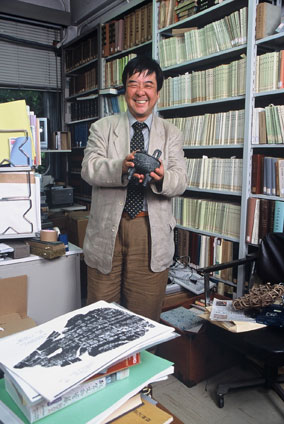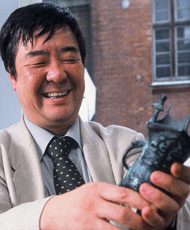Kanji in the Information Age
Each of the various events at the Olympics is identified with a particular symbol, known as a pictogram. These symbols are put to good use in indicating dates and locations of these events. As pictograms deliver meaning visually, people are able to grasp their meanings intuitively, whether they have knowledge underlying their significance or not. The fact that they are not rooted in any particular language also makes them eminently suited for disseminating information at Olympic arenas, international airports, and other places where people of many nationalities, all speaking different languages, are bound to gather. One can see question marks being used to denote information counters the world over, for example. The same is true of a knife beside a fork being used to indicate a restaurant.
Another set of symbols used like pictograms to convey information concisely and efficiently is that of the icons used in computer interfaces. Like pictograms, icons are of simple composition and entirely visual in orientation, and thus, can be understood by anyone, regardless of the language he or she speaks. By some accounts, however, there are thousands of icons nowadays, with different software manufacturers making up their own designs as they please. Moreover, the vast majority of them give no indication whatsoever of having any relation with the software function that they are supposed to represent. This state of affairs means that users must memorize each and every individual icon in software that they are using.
Having come this far, it becomes clear that what we desire in future concepts for methods of disseminating information is 1) that it be capable of communicating meaning in a concise format, and 2) moreover, that it already enjoy a shared awareness among a wide range of social strata. And as it turns out, there exists a system of symbols very near to us in our everyday lives that fits these requirements to a T. I refer, of course, to Kanji (Chinese characters ).
Kanji is the only writing system in the world to have maintained its pictographic state from its origins, more than 3000 years ago, to the present day.Many Kanji are based on representative shapes of specific things. Characters such as "Yama" (Mountain),
"Yama" (Mountain), "Kawa" (River),
"Kawa" (River), "Kame" (Turtle),
"Kame" (Turtle), "Tori" (Bird) even now retain strong visual identifications with the realworld object that they represent. And we can use these characters based on their meanings, without having to know what their Chinese pronunciations are. What this means is that these characters are, in fact, icons created by the Chinese 3000 years ago, and are not tied to any particular language. And if their representation functionality is separated from Chinese, Japanese, or any other particular language, they would also be a wholly effective means of communicating information even to persons living in parts of the world where Kanji are not used, either wholly or in part, as the writing system, such as Europe and North America.
"Tori" (Bird) even now retain strong visual identifications with the realworld object that they represent. And we can use these characters based on their meanings, without having to know what their Chinese pronunciations are. What this means is that these characters are, in fact, icons created by the Chinese 3000 years ago, and are not tied to any particular language. And if their representation functionality is separated from Chinese, Japanese, or any other particular language, they would also be a wholly effective means of communicating information even to persons living in parts of the world where Kanji are not used, either wholly or in part, as the writing system, such as Europe and North America.
For example, both ("soku": rapid, prompt) and
("soku": rapid, prompt) and ("sude ni": already, previously) both have the element
("sude ni": already, previously) both have the element on their left side. This element is in the shape of food piled atop a plate, bowl, or other container or vessel. Conversely, the right hand portion of
on their left side. This element is in the shape of food piled atop a plate, bowl, or other container or vessel. Conversely, the right hand portion of ,
, , is the shape of a person kneeling and opening his or her mouth wide (Figure 1). Combined, this character indicates a person about to devour food in front of them right now, giving it the meaning of "right away, right now, any moment now," or words to that effect. On the other hand, while
, is the shape of a person kneeling and opening his or her mouth wide (Figure 1). Combined, this character indicates a person about to devour food in front of them right now, giving it the meaning of "right away, right now, any moment now," or words to that effect. On the other hand, while has the same left hand component, its right hand component,
has the same left hand component, its right hand component, , is essentially the opposite to that of the previous character. That is to say, this kneeling person, his or her stomach now full, has now turned their back on the food sitting in front of them (Figure 2). Thus, this character indicates that this person is no longer interested in eating, giving it the meaning of "things already having been finished."
, is essentially the opposite to that of the previous character. That is to say, this kneeling person, his or her stomach now full, has now turned their back on the food sitting in front of them (Figure 2). Thus, this character indicates that this person is no longer interested in eating, giving it the meaning of "things already having been finished."
In other words, these characters, and
and , are composed of exactly the same elements. The only difference between them is the facing, that is, which way the kneeling person is turning his or her mouth.
, are composed of exactly the same elements. The only difference between them is the facing, that is, which way the kneeling person is turning his or her mouth.
Let us now take one more example, that of ("iku," to grow or educate) and
("iku," to grow or educate) and ("suki," to like or love). The character
("suki," to like or love). The character is constructed from oldfashioned characters for
is constructed from oldfashioned characters for , meaning "woman," and
, meaning "woman," and , meaning "child," with this "child" element being turned upside down, and placed on top of the "woman's" pelvis. The image thus depicted is that of childbirth, and in fact, the character
, meaning "child," with this "child" element being turned upside down, and placed on top of the "woman's" pelvis. The image thus depicted is that of childbirth, and in fact, the character originally meant "to give birth" (Figure 3). The reason this character was eventually written in why its present form was due to the fact that the component for
originally meant "to give birth" (Figure 3). The reason this character was eventually written in why its present form was due to the fact that the component for was replaced with
was replaced with ("flesh"), and the positions of the two components were inverted as well. On the other hand, the character
("flesh"), and the positions of the two components were inverted as well. On the other hand, the character is also comprised of the same two components,
is also comprised of the same two components, "woman," and
"woman," and "child." In this case, the character connotes "liking or loving" through the image of a woman being fond of her own child (Figure 4). Or to put it another way, it indicates that something is "good or desirable." The components, however, are placed side by side, in a horizontal orientation. Or, in other words, the only difference between
"child." In this case, the character connotes "liking or loving" through the image of a woman being fond of her own child (Figure 4). Or to put it another way, it indicates that something is "good or desirable." The components, however, are placed side by side, in a horizontal orientation. Or, in other words, the only difference between and
and is the position and orientation of their component elements.
is the position and orientation of their component elements.
As we have seen, the position and orientation of component elements of Kanji play an important role in determining their meanings, which in turn specifically indicate the overall meaning visually in a great many instances. And this is the biggest factor behind the easily comprehensible nature of Kanji, that is, in making it possible for people to comprehend the meaning of Kanji the instant they see it.

All available space in Prof. Atsuji's laboratory is covered with data files and other texts.
Today, when our societies are being driven primarily by information interchange, it seems clear that we should be taking another look at the effective way Kanji delivery information by transcending language and being rapidly comprehended.
The writing system that has been in use longer than any other in the world contains the brightest potential for the future.

Tetsuji Atsuji
Born in 1951.
Graduate of the doctoral program, Graduate School of Letters, Kyoto University
MA, Kyoto University
Professor, Graduate School of Human and Environmental Studies, Kyoto University
URL http://www.h.kyoto-u.ac.jp/jimu/staff/242_atsuji_t_0_e.html (External Link)
"Writing systems are bound up in complex ways with many aspects of our everyday lives. These relations between people and their writing systems are of interest to me."
Kyoto University has a tradition of research into Kanji (Chinese characters) that dates back to before World War II. The scope of Prof. Atsuji's research, however, does not stop at the traditional focus of such work, interpretation of literature and other documents. Having survived over more than 3000 years, being brought in contact with many different languages over that period, Kanji is a covetous writing system, with a vitality that the Professor himself shares. The inspiration for his ideas about treating Kanji as an implement for use in our everyday lives comes from his own upbringing. The family business was that of a printer, and thus, he grew up surrounded by rows of typeset characters in print shops. He says that Kanji was literally part and parcel of his everyday existence.
Increasing adoption of computers has eased the burden of learning and using Kanji on people who do not live in parts of the world where Kanji are used as the standard writing system. And we welcome researchers who come to study here, bringing new and different viewpoints on Kanji from all over the world to Kyoto University.





